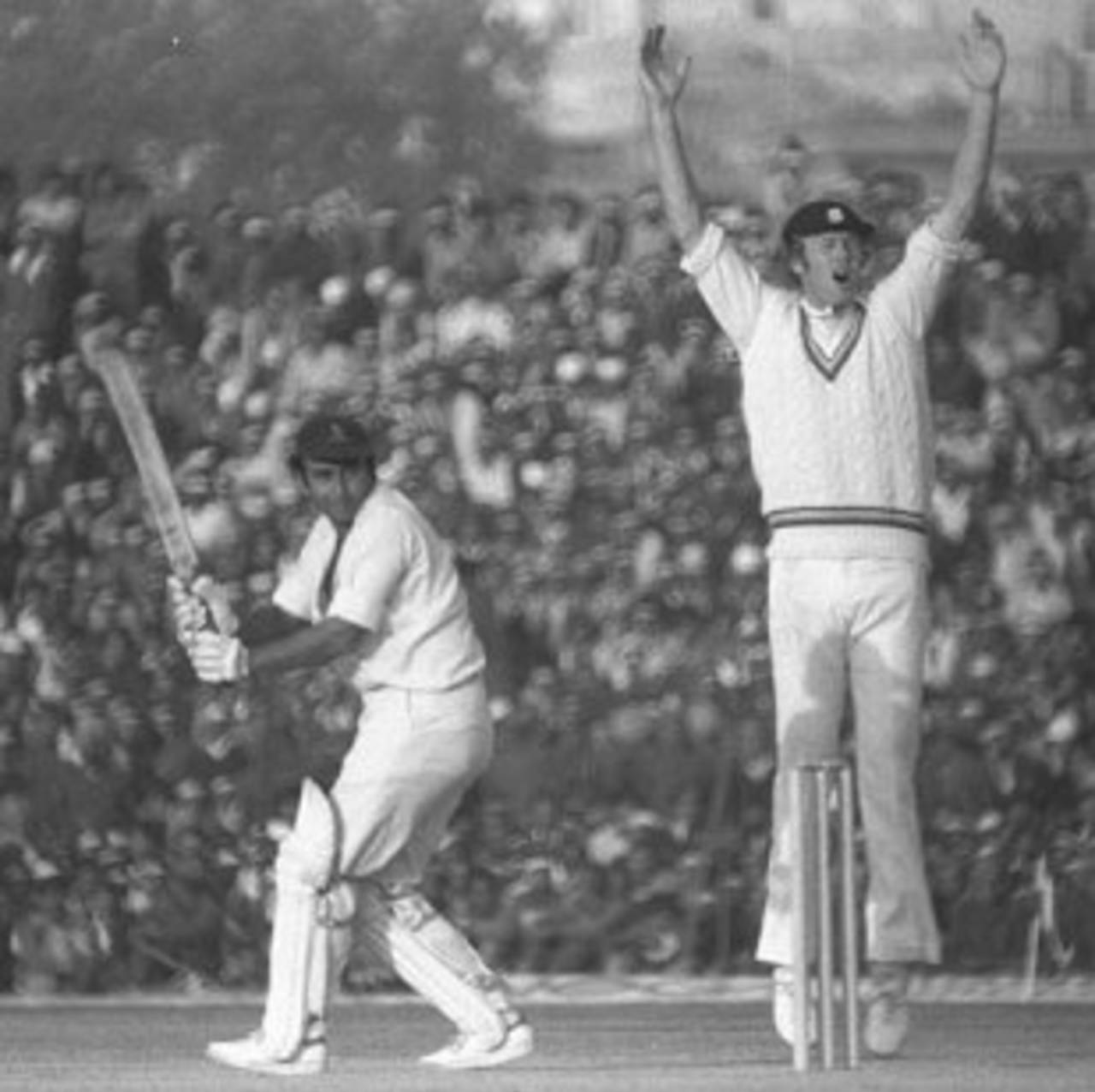Tony Greig: Turning cricketers from Patriots into Professionals
Seemingly a giant of a man, literally and figuratively, he was the captain of a team central to the Indian team's understanding of itself in the cricket world
Samir Chopra
25-Feb-2013

Tony Greig appeals during the 1977 Calcutta Test • The Cricketer International
On December 17, 1976 as the bell rang for the lunch recess at my Delhi school, a gaggle of fifth graders, including myself, came together, lunch-boxes and transistor radios in tow, to check on the cricket scores. The first Test between the Marylebone Cricket Club (MCC) and India was underway at the Ferozeshah Kotla, and thus far, on that bright Delhi winter morning, we had been denied updates. I did not own a radio myself so I was dependent on my classmates for a ticket to the ground. I walked over to a young lad, the ubiquitous square-shaped little box glued to his ear, and asked for the score. The MCC were batting, and stunningly, five wickets had already fallen for a little over a hundred on the board.
I wasn't done yet though. "Is Greig out?" I asked. "Yes." "How much?" "Twenty-five." Twenty-five! Stunned, I wandered away, my fingers nervously strumming the edges of my lunchbox; how was it possible for such a giant of a man to be out for such a low score? I've responded with shock on hearing the news of a favourite player's dismissal many times, but this was something else altogether: giants were not so easily felled by midgets, after all.
Last year, when I penned a short tribute to Mansur Ali Khan Pataudi on the occasion of his passing away, I wrote up a cricketing XI consisting of players particularly important to me:
[T]hose cricketers whose presence in some dimly perceived consciousness in my childhood became the basis of a romantic affiliation with the game. I heard and read about them before I saw their images, whether electronic or photographic. Some of them I never saw perform live at a stadium. But they have left a deeper imprint than many I have seen perform hundreds of times on television. In this case, the vivacity of a child's imagination far outstrips the not inconsiderable workings of the modern media machine.
Tony Greig was a member of that eleven. In the cricketing India of the 1970s, few names carried as much gravitas as he did. Seemingly a giant of a man, literally and figuratively, he was the captain of a team central to the Indian team's understanding of itself in the cricket world, England, one whose cricketing feats, in those days of limited television coverage, grew seemingly boundlessly in a schoolboy's imagination. Greig's interactions with Indian crowds -- and perhaps, later, with television fans and Twitter followers - were legendary; he had, according to Sunny Gavaskar, also mastered a short and pungent vocabulary of Indian expletives, all the better to use against his opponents while fielding at silly point. And he never stopped being combative, colourful or contrary on the field.
In the 1976-77 series, as England rattled off three straight wins against India on Indian grounds, he contributed mightily with the bat as well: in a low-scoring series, in those three Tests, he scored 223 runs in five innings at an average of 55.75, including an epic 103 at Calcutta - made with a fever -that took all of seven hours and ensured an English win. He clearly knew how to play Indian spin bowlers at home. And he was no slouch against quick bowling either. Whatever his troubles with the West Indies in 1976, he never backed away from a battle with their quicks, and neither did he do so against Thomson and Lillee in the 1974-75 Ashes.
Greig's presence in the modern fan's imagination is a function of his role as a commentator: garrulous, opinionated, excitable, and prickly. This earned him plentiful scorn by those stung by his coarse or hasty judgments, or those who just wished he would turn it down.
But for many, including this writer, his place in the modern cricketing world will be ensured by something far more significant: the role he played--via his involvement in World Series Cricket - in facilitating the movement of the cricket player toward becoming a true professional, one not tied down by a national board, one whose name appears on perhaps the most famous legal action in cricketing history: Greig vs. Insole [1978] 1 WLR 302, Courts of the Chancery Division. If you consider yourself a serious cricket fan, and wish to understand why modern cricket has the shape that it does and how it might change in the future, you owe it to yourself to read about the history that led to this case, and what its relevance is to the player of today. Modern players too, should take a look at their paychecks, and thank Greig.
Tony, I think, would be happy, if after all the accounting of runs, wickets, and captaincy successes that pegs him as only a moderate player, he would be reckoned a true revolutionary just for that contribution to the professionalization of today's cricketer.
My new book Brave New Pitch: The Evolution of Modern Cricket is now available at Flipkart and Amazon.
Samir Chopra lives in Brooklyn and teaches Philosophy at the City University of New York. He tweets here